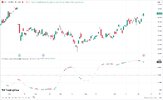- Joined
- 28 December 2013
- Posts
- 6,392
- Reactions
- 24,319
Pondering the Share Market
At the core, people want to make a quick buck, believing that stock prices will increase over time. Buying with the anticipation of selling later at a higher price and generating a profit. This prospect of increased wealth is a major draw for many.
Making money from the markets is a difficult process. After some time in the markets, the process becomes an interesting endeavour, like any other worthwhile pursuit.
Beyond this, some seek to profit from short-term price movements through active trading. The thrill of trying to time the market and capitalise on volatility can be highly addictive, even though it also carries significant risks. The potential rewards, however, can be worth the applied effort.
Ultimately, the share market provides a platform for all to not only grow their wealth but also to experience a sense of participation. While the path is riddled with perils, the allure of the potential rewards continues to attract a wide range of people.
Skate.
At the core, people want to make a quick buck, believing that stock prices will increase over time. Buying with the anticipation of selling later at a higher price and generating a profit. This prospect of increased wealth is a major draw for many.
Making money from the markets is a difficult process. After some time in the markets, the process becomes an interesting endeavour, like any other worthwhile pursuit.
Beyond this, some seek to profit from short-term price movements through active trading. The thrill of trying to time the market and capitalise on volatility can be highly addictive, even though it also carries significant risks. The potential rewards, however, can be worth the applied effort.
Ultimately, the share market provides a platform for all to not only grow their wealth but also to experience a sense of participation. While the path is riddled with perils, the allure of the potential rewards continues to attract a wide range of people.
Skate.
















